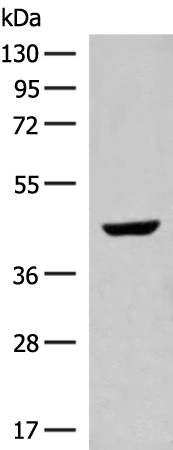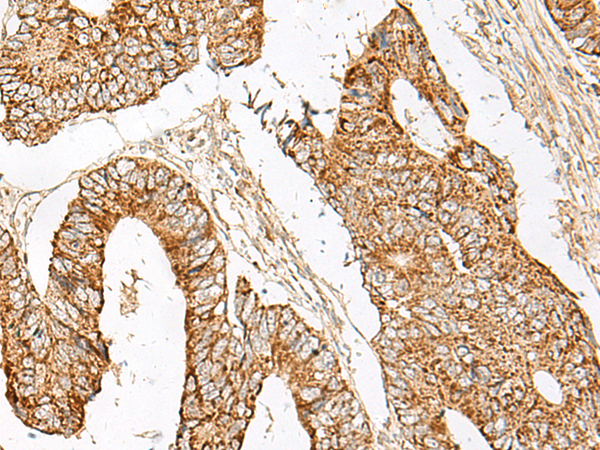

| WB | 咨询技术 | Human,Mouse,Rat |
| IF | 咨询技术 | Human,Mouse,Rat |
| IHC | 1/30-1/150 | Human,Mouse,Rat |
| ICC | 技术咨询 | Human,Mouse,Rat |
| FCM | 咨询技术 | Human,Mouse,Rat |
| Elisa | 1/5000-1/10000 | Human,Mouse,Rat |
| Aliases | GBT1; GNATR; CSNB1G; CSNBAD3 |
| WB Predicted band size | 40 kDa |
| Host/Isotype | Rabbit IgG |
| Antibody Type | Primary antibody |
| Storage | Store at 4°C short term. Aliquot and store at -20°C long term. Avoid freeze/thaw cycles. |
| Species Reactivity | Human, Mouse |
| Immunogen | Synthetic peptide of human GNAT1 |
| Formulation | Purified antibody in PBS with 0.05% sodium azide and 50% glycerol. |
+ +
以下是关于GNAT1抗体的3篇代表性文献摘要:
---
1. **文献名称**: "Mutations in the gene encoding the alpha subunit of the rod cGMP-gated channel in autosomal recessive retinitis pigmentosa"
**作者**: Dryja TP, et al. (1993)
**摘要**: 该研究首次克隆并分析了人类GNAT1基因在视网膜视杆细胞中的表达,利用特异性抗体定位GNAT1蛋白,揭示了其突变与先天性静止性夜盲症(CSNB)的关联,证实了GNAT1在光信号转导中的关键作用。
---
2. **文献名称**: "Immunocytochemical localization of transducin in rod photoreceptor cells using a polyclonal antibody"
**作者**: Liang J, et al. (1995)
**摘要**: 通过制备多克隆抗体,研究团队系统定位了GNAT1蛋白在视网膜中的分布,发现其在视杆细胞外段的特异性富集,为研究光信号通路中G蛋白的动态调节提供了工具。
---
3. **文献名称**: "Functional analysis of GNAT1 mutations in autosomal dominant congenital stationary night blindness"
**作者**: Rao VR, et al. (1997)
**摘要**: 利用GNAT1抗体进行免疫印迹和免疫荧光实验,研究发现某些显性突变导致GNAT1蛋白稳定性下降,干扰视紫红质与G蛋白偶联,进而影响暗视觉信号传递。
---
**备注**:若需更多文献或具体实验应用案例(如Western blot、免疫组化等),可进一步补充。
The GNAT1 antibody is a crucial tool for studying the alpha subunit of the G-protein transducin, encoded by the *GNAT1* gene, which plays a pivotal role in phototransduction in vertebrate retinal rod cells. Expressed predominantly in rod photoreceptors, GNAT1 couples with light-activated rhodopsin to initiate the visual signaling cascade. Upon photon absorption, rhodopsin activates GNAT1. triggering the exchange of GDP for GTP. This activates phosphodiesterase-6 (PDE6), which hydrolyzes cGMP, leading to the closure of cyclic nucleotide-gated (CNG) ion channels and hyperpolarization of the photoreceptor—a key step in converting light into neural signals.
GNAT1 antibodies are widely used in research to investigate retinal function, inherited visual disorders (e.g., congenital stationary night blindness, CSNB), and GNAT1 expression patterns. They enable techniques like Western blotting, immunohistochemistry, and immunofluorescence to localize and quantify GNAT1 in tissues or cell models. Validated antibodies are essential for distinguishing GNAT1 from homologous G-protein subunits (e.g., GNAT2 in cones) and assessing mutations affecting protein stability or function.
Dysregulation of GNAT1 is linked to impaired dark adaptation and vision loss, making these antibodies valuable for both basic research and diagnostic applications. Specificity is often confirmed using knockout controls or epitope mapping. Commercial GNAT1 antibodies are typically raised in rabbits or mice, with clones validated for sensitivity across species like humans, mice, and bovine models.
×